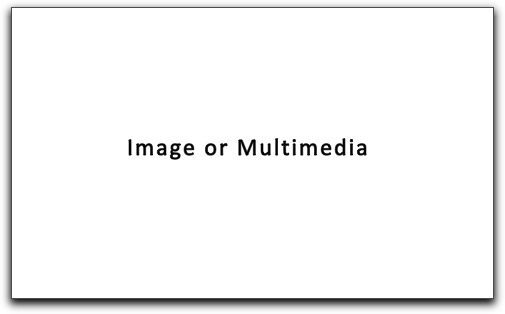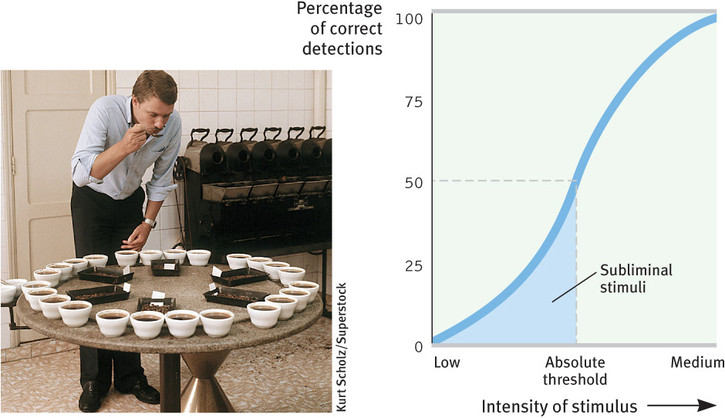Chapter 1. Principles of Sensation and Perception
Twenty-four hours a day, all kinds of stimuli from the outside world bombard your body. Meanwhile, in a silent, cushioned, inner world, your brain floats in utter darkness. By itself, it sees nothing. It hears nothing. It feels nothing. So, how does the world out there get in? How do we normally construct our representations of the external world? http://www.google.com1.1 Introduction
HEATHER SELLERS, AN ACCLAIMED WRITER and teacher, cannot recognize faces. Her vision is perfect, but her perception is not. In her book, Face First (2008), Sellers tells of awkward moments resulting from her lifelong prosopagnosia—face blindness.
In college … I returned from the bathroom and plunked myself down in the wrong booth, facing the wrong man. I remained unaware he was not my date even as my date (a stranger to me) accosted Wrong Booth Guy, and then stormed out…. I do not recognize myself in photos or videos. I can’t recognize my step-sons in the soccer pick-up line; I failed to determine which husband was mine at a party, in the mall, at the market.
People sometimes see Sellers as snobby. “Why did you walk past me?” a neighbor might later say. Hoping to avoid offending others, Sellers sometimes fakes recognition. She smiles at people she passes, in case she knows them, and may pretend to know the person with whom she is talking. But there is an upside to these perception failures. When encountering someone who previously irritated her, she typically won’t feel ill will. She doesn’t recognize the person. A video documenting a British man with prosopagnosia is shown in Figure 1.1. Watch that video now to get a better sense of what it's like to live with face blindness.
This curious mix of “perfect vision” and face blindness illustrates the distinction between sensation and perception. When Sellers looks at a friend, her sensation is normal. Her senses detect the same information yours would, and they transmit that information to her brain. And her perception—the processes by which her brain organizes and interprets the sensory input—is almost normal. Thus, she may recognize people from their hair, walk,voice, or peculiar build—just not from their face. Her experience is much like yours or mine if we were struggling to recognize a specific penguin in a group of waddling penguins.
This curious mix of “perfect vision” and face blindness illustrates the distinction between sensation and perception. When Sellers looks at a friend, her sensation is normal. Her senses detect the same information yours would, and they transmit that information to her brain. And her perception—the processes by which her brain organizes and interprets the sensory input—is almost normal. Thus, she may recognize people from their hair, walk,voice, or peculiar build—just not from their face. Her experience is much like yours or mine if we were struggling to recognize a specific penguin in a group of waddling penguins.
- Frogs, which feed on flying insects, have cells in their eyes that fire only in response to small, dark, moving objects. A frog could starve to death knee-deep in motionless flies. But let one zoom by and the frog’s “bug detector” cells snap awake.
- Male silkworm moths’ odor receptors can detect one-billionth of an ounce of sex attractant per second released by a female one mile away. That is why there continue to be silkworms.
- Human ears are most sensitive to sound frequencies that include human voices, especially a baby’s cry.
We begin our exploration of such sensory gifts by considering questions that cut across all our sensory systems.

Question 1.1 Prosopagnosia, Sensation, and Perception
Prosopagnosia is a selective inability to recognize . This is a cognitive deficit that affects , but not .
1.2 From Energy to Neural Impulse
Every second of every day, your sensory systems perform an amazing feat: They convert one sort of energy into another. Vision processes light energy. Hearing processes sound waves. All your senses:

- receive sensory stimulation, often using specialized receptor cells.
- transform that stimulation into neural impulses.
- deliver the neural information to your brain.
The process of converting one form of energy into another form that your brain can use is called transduction (Figure 1.2). In other chapters, we’ll ask more detailed questions. How do the senses work? How do we see? Hear? Smell? Taste? Feel pain? Keep our balance? In each case, we’ll consider these three steps—receiving, transforming, and delivering the information that your brain uses to form your perceptions.
1.3 Thresholds
At this moment, you and I are being struck by x-rays and radio waves, ultraviolet and infrared light, and sound waves of very high and very low frequencies. To all of these we are blind and deaf. Other animals with differing needs detect a world that lies beyond our experience (Hughes, 1999). Birds stay on course using a magnetic compass. Bats and dolphins locate prey with the help of sonar, bouncing sounds off objects. On cloudy days,bees navigate by detecting aspects of sunlight we cannot see. The shades on our senses are open just a crack, giving us only a tiny glimpse of the energy around us. But for our needs,this is enough.
Absolute Thresholds
To some kinds of stimuli we are amazingly sensitive. From a mountain peak on an utterly dark, clear night, most of us could see a candle flame atop another mountain 30 miles away. We could feel the wing of a bee falling on our cheek. We could even smell a single drop of perfume in a three-room apartment (Galanter, 1962).
Our awareness of these faint stimuli illustrates our absolute thresholds—the minimum stimulation needed to detect a particular light, sound, pressure, taste, or odor 50 percent of the time. To test your absolute threshold for sounds, for example, a hearing specialist would send tones, at varying levels, into each of your ears. The tester would then record whether or not you could hear each tone. The test results would show the point where half the time you could detect the sound and half the time you could not. That 50-50 point would define your absolute threshold for that sound.
Difference Thresholds
To function effectively, we need absolute thresholds low enough to allow us to detect important sights, sounds, textures, tastes, and smells. We also need to detect small differences among stimuli. A musician must detect tiny differences when tuning an instrument. Parents must detect the sound of their own child’s voice amid other children’s voices.

Psychologists call the minimum difference the difference threshold (or the just noticeable difference [jnd], Figure 1.3) We define this as the minimum difference a person can detect between any two stimuli half the time. That detectable difference increases with the size of the stimulus. Thus, if you add 1 ounce to a 10-ounce weight, you will detect the difference. If you add 1 ounce to a 100-ounce weight, you will not. More than a century ago, Ernst Weber noted something so simple but so true that we refer to it as Weber’s law and still apply it. This law states that for an average person to perceive a difference, two stimuli must differ by a constant minimum proportion—not a constant amount. The exact proportion varies, depending on the stimulus. Two lights, for example, must differ in intensity by 8 percent. Two objects must differ in weight by 2 percent. And two tones must differ in frequency by only 0.3 percent (Teghtsoonian, 1971).
1.4 Subliminal Stimulation

Hoping to penetrate our unconscious, marketers offer audio and video programs to help us lose weight, stop smoking, or improve our memories. Soothing ocean sounds may mask messages we cannot consciously hear,such as “I am thin,” “Cigarettes taste bad,” or “I do well on tests. I have total recall of information.” These subliminal messages, below our absolute threshold of awareness, can, we are told, change our lives. Such claims make two assumptions: (1) We can unconsciously subliminal stimuli (). (2) Without our awareness, these stimuli have suggestive powers. Can we? Do they?
Can we be affected by stimuli so weak that we don’t notice them? Under certain conditions, yes. An unnoticed image or word can briefly prime your response to a later question. Let’s see how this might work in a laboratory experiment. You’ve been asked to view a series of slides of people and to give them either positive or negative ratings. But the trickster researchers also flash another image an instant before showing you each slide. Some of the flashed images will be emotionally positive (kittens, a romantic couple) and some will be negative (a werewolf, a dead body). You will consciously perceive these images only as flashes of light.Will they affect your ratings?
In this real experiment (Krosnick & others, 1992), participants gave more positive ratings to people paired with positive images. People somehow looked nicer if their photo immediately followed unperceived kittens rather than an unperceived werewolf. This priming effect happened even though the viewer’s brain did not have enough time to fully process the images and consciously perceive them. Once again, we see the two-track mind at work: Much of our information processing occurs automatically, out of sight, off the radar screen of our conscious mind.
So subliminal sensation is a fact. But does this mean that claims of subliminal persuasion are also facts? Can subliminal recordings really help us make lasting behavioral changes, such as eating less or quitting smoking? Research results from 16 experiments on the influence of subliminal self-help recordings reached the same conclusion. Not one of the recordings helped more than a placebo (Greenwald & others, 1991, 1992). And placebos work only because we believe they will work.
Research shows that people can perceive stimuli that they don't consciously notice.
Question 1.2 Subliminal suggestion
Research shows that people can perceive stimuli that they don't consciously notice.
| A. |
| B. |
Research shows that subliminal stimuli can have lasting behavioral effects on people.
| A. |
| B. |
1.5 Sensory Adaptation
Entering your neighbors’ living room, you smell a musty odor. You wonder how they can stand it, but within minutes you no longer notice it. Sensory adaptation has come to your rescue. When we are constantly exposed to a stimulus that does not change, we become less aware of it because our nerve cells fire less frequently.
Experience sensory adaptation yourself now: move your watch up your wrist an inch, pull a shirtsleeve up or down a bit, or untie and re-tie a shoe, making it a bit tighter or looser than it was before. You will feel the change—but only for a few moments.
Why, then, if we stare at an object without flinching, does it not vanish from sight? Because, unnoticed by us, our eyes are always moving, as illustrated by the demonstration in Figure 1.5. This continual quivering ensures that stimulation on the eyes’ receptors is always changing.

What if we actually could stop our eyes from moving? Would sights seem to vanish, as odors do? To find out, psychologists have devised clever instruments that maintain a constant image on the eye’s inner surface. Imagine that we have fitted a volunteer, Mary, with one of these instruments—a miniature projector mounted on a contact lens (Figure 1.6a). When Mary’s eye moves, the image from the projector moves as well. So everywhere that Mary looks, the scene is sure to go.

If we project images through this instrument, what will Mary see? At first,she will see the complete image. But within a few seconds, as her sensory system begins to tire, things get weird. Bit by bit, the image vanishes, only later to reappear and then disappear—often in fragments (Figure 1.6b).
“My suspicion is that the universe is not only queerer than we suppose, but queerer than we can suppose.”
J.B.S. Haldane, Possible Worlds, 1927
Although sensory adaptation reduces our sensitivity, it offers an important benefit: Freedom to focus on informative changes in our environment without being distracted by background chatter. Our sensory receptors are alert to novelty; bore them with repetition and they free our attention for more important things. We will see this principle again and again: We perceive the world not exactly as it is, but as it is useful for us to perceive it.

For a dramatic illustration of a similar principle, watch the video at right, which documents an particularly compelling illustration of a principle called change blindness (Simons, XXXX). In the video, an Introductory Psychology student approaches a counter to volunteer for an experiment. The man behind the counter is actually a confederate in the experiment, and when he reaches down do retrieve a consent form, he switches places with another experimental confederate, who then pops back up and hands the form to the student. Amazingly, around 75 percent of the experimental subjects fail to notice that they are now talking to a completely different person!
If you think about this result in terms of the concepts we've discussed here, it starts to actually make pretty good sense. In the real world (the world where psychology experimenters are not lurking behind counters), you have more important things to pay attention to than the face of a stranger asking you to fill out a form. Therefore, it makes sense to ignore the details of the stranger's face, just as, at a lower level, your sensory systems ignore unchanging or repetitive stimuli.